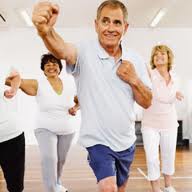
To enjoy a long and healthy life, everyone should make lifestyle choices that include a healthy diet, regular exercise, and maintaining normal weight. The combination of inactivity and eating the wrong foods is the second most common preventable cause of death in the United States (smoking is the first). The benefits of exercise include:
- Decreased risk of cardiovascular (heart) disease, high blood pressure, and stroke.
- Decreased risk of colon and breast cancers.
- Decreased risk of diabetes.
- Decreased risk of osteoporosis.
- Decreased risk of depression and dementia.
Tips for Exercising:
- Drink plenty of fluids before, during, and after a workout.
- Warming up and cooling down are important parts of every exercise routine. They help the body make the transition from rest to activity and back again, and can help prevent soreness or injury, especially in older people. Do warm-up exercises for 5 – 10 minutes at the beginning of an exercise session. Stretching exercises, gentle calisthenics, and walking are ideal.
- To cool down, you should walk slowly until the heart rate is 10 – 15 beats above your resting heart rate. Stopping too suddenly can sharply reduce blood pressure, and is dangerous for older people. It may also cause muscle cramping.
- Do not eat for 2 hours before vigorous exercise.
- When exercising, listen to your body’s warning symptoms.
Motivation:

- Think of exercise as a menu rather than a diet. Choose a number of different physical activities that are personally enjoyable such as sports, dancing, or biking.
- Develop an interest or hobby that requires physical activity.
- Adopt simple routines such as climbing the stairs instead of taking the elevator, walking instead of driving to the local newsstand, or canoeing instead of zooming along in a powerboat.
- Try cross training (alternating between several types of exercises).
- Exercise with friends.
Aerobic (Endurance) Training Types:
- Low- to moderate-impact aerobic exercises: Walking, swimming, stair climbing, step classes, rowing, and cross-country skiing. Nearly anyone in reasonable health can engage in some low- to moderate-impact exercise. Brisk walking burns as many calories as jogging for the same distance and poses less risk for injury to muscle and bone.
- High-impact aerobic exercises: Running, dance exercise, tennis, racquetball, squash. High impact exercises are excellent for cardiovascular conditioning, but they increase the risk of complications and are generally not suitable for people who are overweight, elderly, out of condition, or have an injury, arthritis, or other medical problem.
Aerobic Regimens:

As little as one hour a week of aerobic exercises is helpful, but 3 – 4 hours per week are best. Some research indicates that simply walking briskly for 3 or more hours a week reduces the risk for coronary heart disease by 45%. In general, the following guidelines are useful for most individuals:
- For most healthy young adults, the best approach is a mix of low- and higher-impact exercise. Two weekly workouts will maintain fitness, but three to five sessions a week are better.
- People who are out of shape or elderly should start aerobic training gradually. For example, they may start with 5 – 10 minutes of low-impact aerobic activity every other day and build toward a goal of 30 minutes per day, three to seven times a week. (For heart protection, weekly total is the key.)
- Swimming is an ideal exercise for many elderly people, and for certain people with physical limitations. People with physical limitations include pregnant women, individuals with muscle, joint, or bone problems, and those who suffer from exercise-induced asthma.
- People who seek to lose weight should concentrate on calories burnt each week, not the number of workout sessions.
- One way of gauging the aerobic intensity of exercise is to aim for a “talking pace,” which is enough to work up a sweat and still be able to converse with a friend without gasping for breath. As fitness increases, the “talking pace” will become faster and faster.
Flexibility Training (Stretching)

Flexibility training uses stretching exercises. Many stretching exercises are particularly beneficial for the back. In general, flexibility training provides the following benefits:
- Prevents cramps, stiffness, and injuries.
- Improves joint and muscle movement (improved range of motion).
Certain flexibility practices, such as yoga and tai chi, also involve meditation and breathing techniques that reduce stress. Such practices appear to have many health and mental benefits. They may be very suitable and highly beneficial for older people, and for patients with certain chronic diseases. Doctors recommend performing stretching exercises for 10 – 12 minutes at least three times a week. The following are some general guidelines:
- When stretching, exhale and extend the muscles to the point of tension, not pain, and hold for 20 – 60 seconds. (Beginners may need to start with a 5- to 10-second stretch.)
- Breathe evenly and constantly while holding the stretch.
- Inhale when returning to a relaxed position. Holding your breath defeats the purpose; it causes muscle contraction and raises blood pressure.
- When doing stretches that involve the back, relax the spine to keep the lower back flush with the mat, and to work only the muscles required for changing position (often these are only the abdominal muscles).
Specific Exercise Tips for Older People

Studies continue to show that it is never too late to start exercising. Elderly adults who exercise twice a week can significantly increased their body strength, flexibility, balance, and agility. Studies show that even small improvements in physical fitness and activity can prolong life and independent living. A recent study based on a 35-year follow-up showed that in men who increased their physical activity at age 50, the reduction in mortality rate was similar to that of smoking cessation. In fact, after 10 years of increased physical activity, these men had the same mortality rate for their age groups as men who were highly physically active throughout entire adult their lives.
Still, about half of Americans over 60 describe themselves as sedentary (inactive). According to a 2004 report by the Centers for Disease Control and Prevention, about 12% of people aged 65 – 75 years, and 10% of people aged 75 years or older, meet current recommendations for strength training. The following tips for exercising may be helpful:
- Any older person should have a complete physical and medical examination, as well as professional instruction, before starting an exercise program.
- Start low and go slow. For sedentary, older people, one or more of the following programs may be helpful and safe: Low-impact aerobics, gait (step) training, balance exercises, tai chi, self-paced walking, and lower legs resistance training, using elastic tubing or ankle weights. Even in the nursing home, programs aimed at improving strength, balance, gait, and flexibility have significant benefits.
- Strength training assumes even more importance as one ages, because after age 30 everyone undergoes a slow process of muscular weakening (atrophy). This process can be reduced or even reversed by adding resistance training to an exercise program. As little as 1 day a week of resistance training improves overall strength and agility. Strength training also improves heart and blood vessel health.
- Flexibility exercises promote healthy muscle growth and help reduce the stiffness and loss of balance that accompanies aging.
- Chair exercises may be performed by people who are unable to walk.
- Older women are at risk for incontinence accidents during exercise. This can be reduced or prevented by performing Kegel exercises, limiting fluids (without risking dehydration), going to the bathroom frequently, and using leakage prevention pads or insertable devices.
Caution:

No one is too young or too old to exercise. The United States Surgeon General recommends at least 30 minutes of moderate exercise, such as brisk walking, nearly every day. However, vigorous exercise carries risks that people should discuss with a doctor. You should always check with your doctor before starting a new exercise program, especially if you have any of the following risk factors:
- A symptom you have never told your doctor about.
- Arthritis of the hips or knees.
- Blood clots.
- Chest pain.
- Chronic lung disease.
- Diabetes.
- Eye injury or recent eye surgery.
- Family history of a cardiovascular disease.
- Foot or ankle sores that won’t heal.
- Heart disease.
- Heart palpitations.
- Hernia.
- High blood pressure.
- History of smoking.
- Infections.
- Joint swelling.
- Obesity.
- Pain or trouble walking after a fall.
- Shortness of breath.
